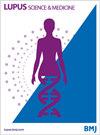甲基强的松龙脉冲增强了咪喹莫特诱发狼疮样疾病小鼠体内中性粒细胞胞外陷阱的形成,导致股骨头软骨缺血
IF 3.7
2区 医学
Q1 RHEUMATOLOGY
引用次数: 0
摘要
目的 甲基强的松龙(methylprednisolone,mPSL)脉冲疗法是活动性系统性红斑狼疮患者的基本选择,但有可能出现与微循环障碍有关的不良事件,包括特发性股骨头坏死(ONFH)。最近的研究发现,过多的中性粒细胞胞外捕获物(NET)参与了微循环障碍。本研究旨在证明 mPSL 脉冲可诱导狼疮小鼠体内的 NETs,并确定导致这种诱导的因素。方法 在第39至41天,给6只患有咪喹莫特(IMQ)诱导的狼疮样疾病的小鼠和6只正常小鼠腹腔注射mPSL,给5只患有IMQ诱导的狼疮样疾病的小鼠和6只正常小鼠注射磷酸盐缓冲盐水。病理学检查评估了股骨头的缺血状态和NET形成的中性粒细胞的组织浸润情况。进行了蛋白质组分析,以提取在注射 mPSL 的 IMQ 诱导的狼疮样疾病小鼠中特异性升高的血浆蛋白质,并在体外评估它们对 NET 形成的影响。结果 接受 mPSL 脉冲治疗的 IMQ 诱导的狼疮样疾病小鼠表现出股骨头软骨缺血,NET 形成的中性粒细胞浸润组织。蛋白质组分析表明,前酰基半胱氨酸氧化酶 1(PCYOX1)在这一现象中发挥了作用。含有 PCYOX1 的极低密度脂蛋白(VLDL)与其底物法呢酰半胱氨酸(FC)反应在体外诱导 NET。联合添加 IMQ 和 mPSL 可协同增强 VLDL 加 FC 诱导的 NET 的形成。结论 PCYOX1 和相关因子值得关注,以了解其基本机制,并为 mPSL 介导的微循环障碍(包括 ONFH)制定新的治疗策略。如有合理要求,可提供相关数据。本文章由计算机程序翻译,如有差异,请以英文原文为准。
Methylprednisolone pulse-enhanced neutrophil extracellular trap formation in mice with imiquimod-induced lupus-like disease, resulting in ischaemia of the femoral head cartilage
Objectives Methylprednisolone (mPSL) pulse therapy is an essential option for patients with active systemic lupus erythematosus, but there is a risk of adverse events related to microcirculation disorders, including idiopathic osteonecrosis of the femoral head (ONFH). Recent studies have revealed that excessive neutrophil extracellular traps (NETs) are involved in microcirculation disorders. This study aimed to demonstrate that mPSL pulse could induce NETs in lupus mice and identify the factors contributing to this induction. Methods Six mice with imiquimod (IMQ)-induced lupus-like disease and six normal mice were intraperitoneally injected with mPSL on days 39 to 41, and five mice with IMQ-induced lupus-like disease and six normal mice were injected with phosphate-buffered saline. Pathological examinations were conducted to evaluate the ischaemic state of the femoral head and tissue infiltration of NET-forming neutrophils. Proteome analysis was performed to extract plasma proteins specifically elevated in mPSL-administered mice with IMQ-induced lupus-like disease, and their effects on NET formation were assessed in vitro. Results Mice with IMQ-induced lupus-like disease that received mPSL pulse demonstrated ischaemia of the femoral head cartilage with tissue infiltration of NET-forming neutrophils. Proteome analysis suggested that prenylcysteine oxidase 1 (PCYOX1) played a role in this phenomenon. The reaction of PCYOX1-containing very low-density lipoproteins (VLDL) with its substrate farnesylcysteine (FC) induced NETs in vitro. The combined addition of IMQ and mPSL synergistically enhanced VLDL-plus-FC-induced NET formation. Conclusion PCYOX1 and related factors are worthy of attention to understand the underlying mechanisms and create novel therapeutic strategies for mPSL-mediated microcirculation disorders, including ONFH. Data are available on reasonable request.
求助全文
通过发布文献求助,成功后即可免费获取论文全文。
去求助
来源期刊

Lupus Science & Medicine
RHEUMATOLOGY-
CiteScore
5.30
自引率
7.70%
发文量
88
审稿时长
15 weeks
期刊介绍:
Lupus Science & Medicine is a global, peer reviewed, open access online journal that provides a central point for publication of basic, clinical, translational, and epidemiological studies of all aspects of lupus and related diseases. It is the first lupus-specific open access journal in the world and was developed in response to the need for a barrier-free forum for publication of groundbreaking studies in lupus. The journal publishes research on lupus from fields including, but not limited to: rheumatology, dermatology, nephrology, immunology, pediatrics, cardiology, hepatology, pulmonology, obstetrics and gynecology, and psychiatry.
 求助内容:
求助内容: 应助结果提醒方式:
应助结果提醒方式:


